Pamela Colman Smith
Biography
Portrait by Alphaeus
Cole, 1906
The lion's share
of this information came from Melinda Boyd Parsons who is working
on a biography of PCS. She has been more than generous with her
research (and she has acres of it!). See the Bibliography for
several of her previous essays, all of which are the best sources
we have now until that biography comes out (just maybe before
the glaciers return!). All misquotes and errors are my own. 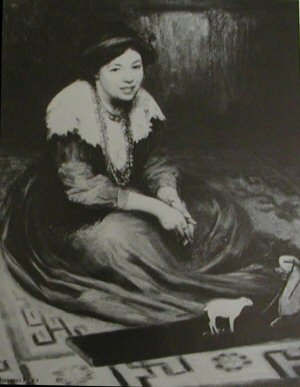 Corinne Pamela Colman
Smith was born on February 16, 1878 in London to Charles Smith
and Corinne Colman. Both parents came from prominent American
families. Charles Smith's family was in trade and law, with interests
in art and collecting. He was related to the actor, William Gillette,
through whom PCS may have met Ellen Terry and the rest of the
theatre crowd. Corinne Colman's family was artistic and mystical,
with several notable painters. Corinne herself was a parlor actress.
All the women in her family seem to be named Pamela, Pamelia,
or Corinne which makes things difficult to sort out.
Corinne Colman and
Charles Smith married in 1870 when Charles was 24 and Corinne
was 34. They may have met through the decorating firm that Charles
worked for or through their, both, avid theatre-going. They were
childless for the first eight years of their marriage and where
they lived is unknown, though trips to England and Jamaica probably
happened because of Charles' work. PCS was their only child.
Charles is mentioned
as artistic, not practical, and not good with money, as PCS will
come to be described. His obituary states he was at one time an
upholstery manufacturer in Manchester, England, and later went
to Jamaica where he was engaged in railroad building.
Charles and Corinne
lived in Manchester for the first 10 years of PCS' life. this
area was still a hotbed of spiritualism and radical thought and
was probably an influence on PCS. The family moved to Jamaica
around 1889 when PCS was 10, and lived there for several years.
Here is where PCS learned the folklore that was an important part
of her life from her nurse.
In 1893 PCS enrolled
in the Pratt Institute in Brooklyn, a co-educational, progressive
school. The school emphasized "manual training" which
educated the whole person - creatively, intellectually, and morally.
Artists were not an elite but vibrant, creative, contributing
members of society. Also here, PCS came under the influence of
Arthur Wesley Dow. Dow was influenced by Japanese art and taught
that pictures could be composed the same way music was composed
by using color, tone, shape, and line - much more abstract than
imitative drawing. Art also had a spiritual content that reflected
the Master Artist and the harmony woven into the substance of
the world. Art was social and spiritual. Art could change the
world. Emotion and ideas could be expressed indirectly but meaningfully
in visual art by drawing or painting synaesthetically using a
harmony of colored spaces.
Synaesthesia involves
the crossing-over of sensory signals - hearing colors, seeing
sounds, smelling music or words, etc. We all have this to some
degree but PCS became famous for her artworks inspired by music.
The music painting were directly channeled by listening to performances
and drawing unconsciously. She often stated that if she paid attention
to the drawing, she lost the image.
Dow's influence on
her commercial artwork is very apparent up to around 1900. What
appears simple, decorative, and childlike is actually very sophisticated.
Nothing like her work had been seen in America up to that time.
PCS is often classified
as a Symbolist. Symbolist art was a significant trend in the fin
de siècle (end of the 1800s). It is difficult to firmly
categorize this movement but there are some common features:
Corinne Pamela Colman
Smith was born on February 16, 1878 in London to Charles Smith
and Corinne Colman. Both parents came from prominent American
families. Charles Smith's family was in trade and law, with interests
in art and collecting. He was related to the actor, William Gillette,
through whom PCS may have met Ellen Terry and the rest of the
theatre crowd. Corinne Colman's family was artistic and mystical,
with several notable painters. Corinne herself was a parlor actress.
All the women in her family seem to be named Pamela, Pamelia,
or Corinne which makes things difficult to sort out.
Corinne Colman and
Charles Smith married in 1870 when Charles was 24 and Corinne
was 34. They may have met through the decorating firm that Charles
worked for or through their, both, avid theatre-going. They were
childless for the first eight years of their marriage and where
they lived is unknown, though trips to England and Jamaica probably
happened because of Charles' work. PCS was their only child.
Charles is mentioned
as artistic, not practical, and not good with money, as PCS will
come to be described. His obituary states he was at one time an
upholstery manufacturer in Manchester, England, and later went
to Jamaica where he was engaged in railroad building.
Charles and Corinne
lived in Manchester for the first 10 years of PCS' life. this
area was still a hotbed of spiritualism and radical thought and
was probably an influence on PCS. The family moved to Jamaica
around 1889 when PCS was 10, and lived there for several years.
Here is where PCS learned the folklore that was an important part
of her life from her nurse.
In 1893 PCS enrolled
in the Pratt Institute in Brooklyn, a co-educational, progressive
school. The school emphasized "manual training" which
educated the whole person - creatively, intellectually, and morally.
Artists were not an elite but vibrant, creative, contributing
members of society. Also here, PCS came under the influence of
Arthur Wesley Dow. Dow was influenced by Japanese art and taught
that pictures could be composed the same way music was composed
by using color, tone, shape, and line - much more abstract than
imitative drawing. Art also had a spiritual content that reflected
the Master Artist and the harmony woven into the substance of
the world. Art was social and spiritual. Art could change the
world. Emotion and ideas could be expressed indirectly but meaningfully
in visual art by drawing or painting synaesthetically using a
harmony of colored spaces.
Synaesthesia involves
the crossing-over of sensory signals - hearing colors, seeing
sounds, smelling music or words, etc. We all have this to some
degree but PCS became famous for her artworks inspired by music.
The music painting were directly channeled by listening to performances
and drawing unconsciously. She often stated that if she paid attention
to the drawing, she lost the image.
Dow's influence on
her commercial artwork is very apparent up to around 1900. What
appears simple, decorative, and childlike is actually very sophisticated.
Nothing like her work had been seen in America up to that time.
PCS is often classified
as a Symbolist. Symbolist art was a significant trend in the fin
de siècle (end of the 1800s). It is difficult to firmly
categorize this movement but there are some common features:
- The reaction against the
dominant materialist, naturalist, and determinist ethos of the
epoch
- A focus on the internal,
symbolical world rather than the external, empirical one - introspection
rather than observation; suggestive rather than nominative
- A highly individualized
execution
- Personal and enigmatic visions
and mystical themes expressed through private symbol rather than
public, consensual allegory or metaphor
- Ideographic content over
purely formal statements reflecting the primacy of spirit, soul,
or imagination
- The femme fatale is often
a primary figure, either as dangerous woman or mysterious woman
or powerful woman
Symbolism was a reaction
against the materialist heritage of the fin de siècle.
It is often confused with the earlier Romanticism, but that was
a reaction against the rationalist heritage of the Age of Enlightenment.
PCS spent from 1893
to 1897 at the Pratt, on and off. She had frequent absences due
to illness and at the end of it all, did not graduate. In 1896,
her mother died while the family was in Jamaica.
In 1897, when she
was 19, she had a feature exhibition, along with Robert Henri,
at William Macbeth's gallery. The show was reviewed in the NY
Times. Four of her watercolors sold.
1899 was the wonder
year for PCS. She published four books, three of which were hers
entirely. The Golden Vanity/Green Bed, Widdicombe Fair, and
Annancy Stories were all her work. The first two were limited
editions with hand-colored prints. Annancy Stories consisted
of Jamaican folk tales with line drawings. The fourth book to
which she contributed color plates and line drawings was In
Chimney Corners by Seamus MacManus. She toured with the Lyceum
Company that year also. She and her father met John Butler Yeats,
Willie's father, in the summer. In December, her father died.
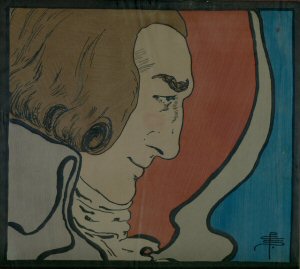
Portrait
of Henry Irving by PCS
The Lyceum Theatre
was based in London and run by the actor, manager Henry Irving,
the first actor to be knighted. Irving was a very prominent actor
in the Victorian era when spectacle or spectacular theatre was
popular. These were massive stage productions with the cast of
hundreds, historically accurate details galore, and a total experience
for the audience. They were rather like today's special effects
extravaganzas in movies where the plot or characters sometimes
are lost in the crowd. Irving, however, was noted for restraint
and taste along with a keen sense of staging, especially lighting.
PCS spent several years touring and working with this company
where she helped with costume design and stage design. These things
are especially evident in her Tarot deck where each card is a
complex vignette meant to convey a particular meaning. She also
learned how to research.
The leading lady with
this theatre company was Ellen Terry, the highest paid actress
of the times. She was a formidable presence and noted for her
charm. PCS lived with her for a time and became fast and lifelong
friends with her daughter Edith Craig (Edy). 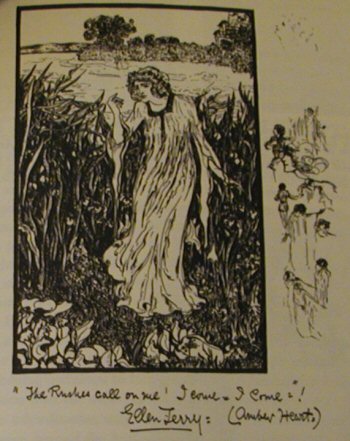 Terry
carried on a famous correspondence with Bernard Shaw which is
available in a book. She led a wide and varied life, coming from
a theatre family, and had several marriages, two children out
of wedlock (the son Gordon Craig became a famous stage designer
and character in his own right), yet still managed to remain admired
by the general public. There are several books on her (and Irving)
that are worth reading. The picture to the right is a sketch by
PCS and shows Terry as Ellaline from The Amber Heart. Ellen
Terry is the person who named PCS Pixie.
Another member of
the Lyceum Theatre was its business manager, Bram Stoker. This
was his day job when he wasn't writing novels, including Dracula.
He was a popular person with the cast and crew and was affectionately
known as 'Uncle Bramy.' PCS illustrated his last novel, Lair
of the White Worm.
Terry
carried on a famous correspondence with Bernard Shaw which is
available in a book. She led a wide and varied life, coming from
a theatre family, and had several marriages, two children out
of wedlock (the son Gordon Craig became a famous stage designer
and character in his own right), yet still managed to remain admired
by the general public. There are several books on her (and Irving)
that are worth reading. The picture to the right is a sketch by
PCS and shows Terry as Ellaline from The Amber Heart. Ellen
Terry is the person who named PCS Pixie.
Another member of
the Lyceum Theatre was its business manager, Bram Stoker. This
was his day job when he wasn't writing novels, including Dracula.
He was a popular person with the cast and crew and was affectionately
known as 'Uncle Bramy.' PCS illustrated his last novel, Lair
of the White Worm. 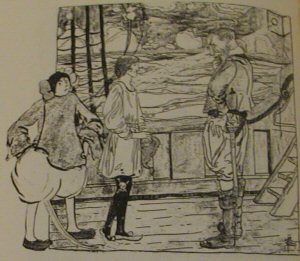 The
illustration to the left shows PCS, Edy, and Uncle Bramy. The
picture is a reworking of one of the prints from Golden Vanity.
Some claim that the character of Dracula was basely loosely on
Henry Irving.
In 1900, PCS illustrated
a souvenir booklet for her cousin, William Gillette, the first
stage and radio Sherlock Holmes. Much of what we know as the regalia
of Holmes was set by Gillette including the dressing gown, the
pipe, the tobacco in a slipper, and the deerstalker hat.
In 1901, PCS joined
the The Hermetic Order of the Golden Dawn, an occult society.
William Butler Yeats and Arthur Edward Waite were also members,
along with Aleister Crowley and a host of others. PCS took the
motto of Quod tibi id alliis, whatever you would have done
to thee, do unto others. Also in this year, Queen Victoria died
and Edward VII became king. Society changed radically as a breath
of fresh air blew in and removed so many of the restraints and
habits of the previous times.
Around the early 1900s,
PCS begins to have visions and paint her 'music paintings.' She
was gifted with a high degree of synaesthesia - she 'saw' music
and was able to transmit those visions into tangible artworks.
Synaesthesia is a crossing-over of sensory input. You 'hear' colors
or 'see' music or 'smell' words and so on. We all have this to
some extent. It is part of our memory and recall process. PCS
developed this synaesthesia to a high degree and her work is compelling,
not for the actual images but for what they imply. Reading the
titles to her various paintings, you are forced to wonder where
in the piece of music she found the images she did. And, also
wonder, what else she saw that did not make it onto the page.
She embodied the Symbolist ideal in this area.
In 1902, she worked
with Jack Yeats on A Broad Sheet. This periodical contained
original art and literature. This inspired her to create her own
version which she started in 1903 as The Green Sheaf. This
venture included contributors such as WB Yeats, Christopher St
John (Christabel Marshall), Cecil French, AE (George William Russell),
Gordon Craig, Dorothy Ward, and John Todhunter. It ran for only
one year. As in many things, PCS' vision did not transmit into
practical, economic success. Both A Broad Sheet (which
ran through 1903) and The Green Sheaf were attempts at
a small periodical, finely crafted. The terrors of mass production
concerned many people who felt that the beauty of life and art
was evaporating under the pressure to get more 'stuff' to more
people. This is a concern we still face today - quality vs quantity
- having a lot of stuff vs having a few nice (expensive) things.
The Arts and Crafts Movement, both in England and America, tried
to address this issue. Nowadays, the artifacts from that movement
command high prices, so in a sense, that venture failed. Technology
seemed to be driving out Art.
Also in 1903 PCS had
an exhibition at John Baillie's gallery in London. This was an
Arts and Crafts specialty shop. She also joined The Masquers,
organized by Walter Crane, which was dedicated to a 'Theatre of
Beauty.' This group disbanded several months later without accomplishing
anything.
In 1904, PCS follows
Arthur Waite to the Independent and Rectified Rite of the Golden
Dawn (or Holy Order of the Golden Dawn). The original Golden Dawn
had splintered due to personality conflicts and conflicting visions
of what the organization should be (and of course, who was in
charge). PCS is a member of the Stage Society at this point and,
with Edith Craig, designed the set for WB Yeats' play Where
There is Nothing.
Back in New York,
on November 25, 1905, Alfred Stieglitz opened his gallery 291
on Fifth Avenue. More correctly, this is called The Little Galleries
of the Photo-Secession. Stieglitz was at the forefront of photography
and set high standards. His own photos are still considered some
of the finest ever made. He also became one of the prime movers
in the modern art movement, bringing the radically evolving works
to the notice of people in America, whether they wanted it or
not. In late December of 1906, PCS walked into this gallery with
a portfolio of her work. There were problems in getting a Rodin
exhibition mounted so, Stieglitz gave PCS a one-woman show, the
first show by a non-photographer at the gallery. He was very impressed
with her 'primitivism,' and the whole mystical process of her
music paintings. They seemed to express "Truth" on paper,
and "Truth" was being actively sought by many artists.
It probably did not hurt that PCS dropped some names, WB Yeats,
Arthur Symons, Ellen Terry. The first ten days of the exhibition
were very lightly attended. Then, a review appeared in the New
York Sun by James Gibbons Honeker that was full of praise.
The gallery filled with people and several paintings were sold.
Stieglitz took photographs of 22 of the paintings and issued a
platinum print portfolio edition of only seven sets.
PCS had two more exhibits
at 291, one in late February of 1908 with Willi Geiger and Donald
Shaw MacLaughlin, and another solo exhibit in mid-March of 1909
- drawings in monochrome and color. The group exhibition was largely
ignored. PCS gave a recital of West Indian nursery rhymes and
chanted ballads at the opening of her third exhibition.
There is a letter
from PCS to Steiglitz dated November 19, 1909 announcing that
she just finished doing a set of 80 drawings for a Tarot deck
for very little money. She offered to send over the original drawings
for him to sell and hinted that she needed money. But nothing
apparently came of that.
So why did Stieglitz
not help PCS? At this point in time he was moving on with American
modernist painters. PCS had for some time allied herself with
England (she did not like Americans). And, probably more importantly,
her work was not what Stieglitz was interested in promoting. More
exciting things were happening on the art fronts and PCS was a
throw-back to an earlier time, synaesthesia and music paintings
notwithstanding. Her execution did not develop into the cutting-edge
experimentation that was rampant. Works by Matisse, Gauguin, Lautrec,
Picasso, Brancusi, Rodin, and others were beginning to be exhibited
in America. Stieglitz was developing several American artists
also such as Marin, Delauney, Hartley. And, Stieglitz always claimed
that his galleries were not marketplaces. He did not promote the
sale of artworks and required buyers to 'qualify' for a piece
of work. Money was not the answer; Desire and understanding were
the answers. Pieces sold at the gallery, but it was not something
on which an artist could depend. Her work fell by the wayside,
as did many artists. She lost a primary cheerleader and exposure.
Back to this Tarot
deck. In December of 1909, Rider and Son published a new Tarot
deck, conceived by Arthur Edward Waite and executed by PCS. Until
that time, Tarot decks were rare, especially in England. They
had to be imported from France and were mostly of
The
illustration to the left shows PCS, Edy, and Uncle Bramy. The
picture is a reworking of one of the prints from Golden Vanity.
Some claim that the character of Dracula was basely loosely on
Henry Irving.
In 1900, PCS illustrated
a souvenir booklet for her cousin, William Gillette, the first
stage and radio Sherlock Holmes. Much of what we know as the regalia
of Holmes was set by Gillette including the dressing gown, the
pipe, the tobacco in a slipper, and the deerstalker hat.
In 1901, PCS joined
the The Hermetic Order of the Golden Dawn, an occult society.
William Butler Yeats and Arthur Edward Waite were also members,
along with Aleister Crowley and a host of others. PCS took the
motto of Quod tibi id alliis, whatever you would have done
to thee, do unto others. Also in this year, Queen Victoria died
and Edward VII became king. Society changed radically as a breath
of fresh air blew in and removed so many of the restraints and
habits of the previous times.
Around the early 1900s,
PCS begins to have visions and paint her 'music paintings.' She
was gifted with a high degree of synaesthesia - she 'saw' music
and was able to transmit those visions into tangible artworks.
Synaesthesia is a crossing-over of sensory input. You 'hear' colors
or 'see' music or 'smell' words and so on. We all have this to
some extent. It is part of our memory and recall process. PCS
developed this synaesthesia to a high degree and her work is compelling,
not for the actual images but for what they imply. Reading the
titles to her various paintings, you are forced to wonder where
in the piece of music she found the images she did. And, also
wonder, what else she saw that did not make it onto the page.
She embodied the Symbolist ideal in this area.
In 1902, she worked
with Jack Yeats on A Broad Sheet. This periodical contained
original art and literature. This inspired her to create her own
version which she started in 1903 as The Green Sheaf. This
venture included contributors such as WB Yeats, Christopher St
John (Christabel Marshall), Cecil French, AE (George William Russell),
Gordon Craig, Dorothy Ward, and John Todhunter. It ran for only
one year. As in many things, PCS' vision did not transmit into
practical, economic success. Both A Broad Sheet (which
ran through 1903) and The Green Sheaf were attempts at
a small periodical, finely crafted. The terrors of mass production
concerned many people who felt that the beauty of life and art
was evaporating under the pressure to get more 'stuff' to more
people. This is a concern we still face today - quality vs quantity
- having a lot of stuff vs having a few nice (expensive) things.
The Arts and Crafts Movement, both in England and America, tried
to address this issue. Nowadays, the artifacts from that movement
command high prices, so in a sense, that venture failed. Technology
seemed to be driving out Art.
Also in 1903 PCS had
an exhibition at John Baillie's gallery in London. This was an
Arts and Crafts specialty shop. She also joined The Masquers,
organized by Walter Crane, which was dedicated to a 'Theatre of
Beauty.' This group disbanded several months later without accomplishing
anything.
In 1904, PCS follows
Arthur Waite to the Independent and Rectified Rite of the Golden
Dawn (or Holy Order of the Golden Dawn). The original Golden Dawn
had splintered due to personality conflicts and conflicting visions
of what the organization should be (and of course, who was in
charge). PCS is a member of the Stage Society at this point and,
with Edith Craig, designed the set for WB Yeats' play Where
There is Nothing.
Back in New York,
on November 25, 1905, Alfred Stieglitz opened his gallery 291
on Fifth Avenue. More correctly, this is called The Little Galleries
of the Photo-Secession. Stieglitz was at the forefront of photography
and set high standards. His own photos are still considered some
of the finest ever made. He also became one of the prime movers
in the modern art movement, bringing the radically evolving works
to the notice of people in America, whether they wanted it or
not. In late December of 1906, PCS walked into this gallery with
a portfolio of her work. There were problems in getting a Rodin
exhibition mounted so, Stieglitz gave PCS a one-woman show, the
first show by a non-photographer at the gallery. He was very impressed
with her 'primitivism,' and the whole mystical process of her
music paintings. They seemed to express "Truth" on paper,
and "Truth" was being actively sought by many artists.
It probably did not hurt that PCS dropped some names, WB Yeats,
Arthur Symons, Ellen Terry. The first ten days of the exhibition
were very lightly attended. Then, a review appeared in the New
York Sun by James Gibbons Honeker that was full of praise.
The gallery filled with people and several paintings were sold.
Stieglitz took photographs of 22 of the paintings and issued a
platinum print portfolio edition of only seven sets.
PCS had two more exhibits
at 291, one in late February of 1908 with Willi Geiger and Donald
Shaw MacLaughlin, and another solo exhibit in mid-March of 1909
- drawings in monochrome and color. The group exhibition was largely
ignored. PCS gave a recital of West Indian nursery rhymes and
chanted ballads at the opening of her third exhibition.
There is a letter
from PCS to Steiglitz dated November 19, 1909 announcing that
she just finished doing a set of 80 drawings for a Tarot deck
for very little money. She offered to send over the original drawings
for him to sell and hinted that she needed money. But nothing
apparently came of that.
So why did Stieglitz
not help PCS? At this point in time he was moving on with American
modernist painters. PCS had for some time allied herself with
England (she did not like Americans). And, probably more importantly,
her work was not what Stieglitz was interested in promoting. More
exciting things were happening on the art fronts and PCS was a
throw-back to an earlier time, synaesthesia and music paintings
notwithstanding. Her execution did not develop into the cutting-edge
experimentation that was rampant. Works by Matisse, Gauguin, Lautrec,
Picasso, Brancusi, Rodin, and others were beginning to be exhibited
in America. Stieglitz was developing several American artists
also such as Marin, Delauney, Hartley. And, Stieglitz always claimed
that his galleries were not marketplaces. He did not promote the
sale of artworks and required buyers to 'qualify' for a piece
of work. Money was not the answer; Desire and understanding were
the answers. Pieces sold at the gallery, but it was not something
on which an artist could depend. Her work fell by the wayside,
as did many artists. She lost a primary cheerleader and exposure.
Back to this Tarot
deck. In December of 1909, Rider and Son published a new Tarot
deck, conceived by Arthur Edward Waite and executed by PCS. Until
that time, Tarot decks were rare, especially in England. They
had to be imported from France and were mostly of 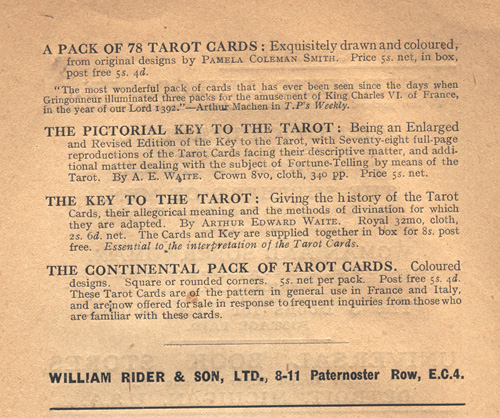 the
Marseille type. The great innovation of this new Tarot deck was
its pictorial evocative Minor cards, those numbered one through
ten. These cards now had scenes to illustrate meanings and not
just four cups or seven swords. The advert to the left is from
the January 1910 copy of The Occult Review. This is one
of the first (and many) times that PCS' name will be misspelled
- Coleman not Colman. The deck was intended to be a mass-market
deck but with occult overtones. Waite was not letting all the
secrets out. It has been the most influential deck of the modern
times. Many decks are merely redressings of this one. The most
important influence was in those illustrated Minor cards. The
deck is still in production in a modified form as the Rider Tarot©
or the Rider Waite Tarot©.
Also in 1909, PCS
joined the Suffrage Atelier in London working for the vote for
women. She contributed posters and other artwork to the cause.
the
Marseille type. The great innovation of this new Tarot deck was
its pictorial evocative Minor cards, those numbered one through
ten. These cards now had scenes to illustrate meanings and not
just four cups or seven swords. The advert to the left is from
the January 1910 copy of The Occult Review. This is one
of the first (and many) times that PCS' name will be misspelled
- Coleman not Colman. The deck was intended to be a mass-market
deck but with occult overtones. Waite was not letting all the
secrets out. It has been the most influential deck of the modern
times. Many decks are merely redressings of this one. The most
important influence was in those illustrated Minor cards. The
deck is still in production in a modified form as the Rider Tarot©
or the Rider Waite Tarot©.
Also in 1909, PCS
joined the Suffrage Atelier in London working for the vote for
women. She contributed posters and other artwork to the cause.
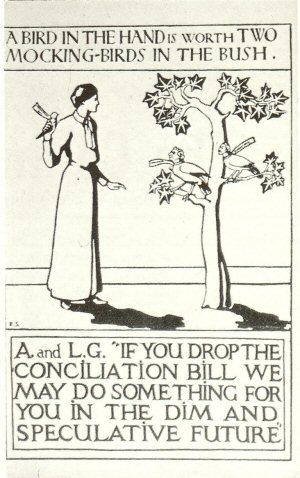 Below is one of the
postcards, signed PS as she did for these items.. The Suffrage
Atelier joined women and men together to produce media for the
movement. Posters, postcards, programs, banners, all these things
emphasized the need for women to get the vote.
And in 1909, PCS began
to study for her conversion to Catholicism which took place in
1911.
In 1911, The Pioneer
Players were formed by Edith Craig and PCS was a member. This
group put on independent theatre programs, a theatre of ideas,
though they have been often lumped in with feminist ideals. This
was not quite true as actually more plays be men than women were
presented. The group ran through WW1 (one of only two independent
groups to do so) and after a break, hosted its last performance
in 1925.
Below is one of the
postcards, signed PS as she did for these items.. The Suffrage
Atelier joined women and men together to produce media for the
movement. Posters, postcards, programs, banners, all these things
emphasized the need for women to get the vote.
And in 1909, PCS began
to study for her conversion to Catholicism which took place in
1911.
In 1911, The Pioneer
Players were formed by Edith Craig and PCS was a member. This
group put on independent theatre programs, a theatre of ideas,
though they have been often lumped in with feminist ideals. This
was not quite true as actually more plays be men than women were
presented. The group ran through WW1 (one of only two independent
groups to do so) and after a break, hosted its last performance
in 1925.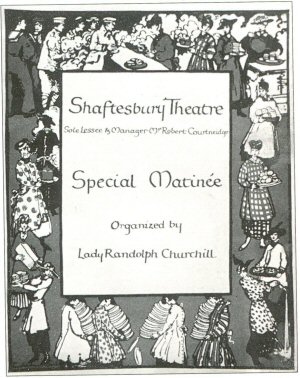 The
picture at the right is from a 1915 charity performance of Evreinov's
play The Theatre of the Soul.
1911 also saw the
publication of The Pictorial Key to the Tarot which now
included PCS line art for the Tarot deck. This book is still in
print under many titles and by many publishers.
In 1912, Gustave Stickley's
Arts and Crafts magazine, The Craftsman, published an article
on PCS by M Irwin MacDonald titled "The Fairy Faith and Pictured
Music of Pamela Colman Smith." This article was illustrated
with many painting and drawings by her.
In 1913, Ellen Terry
wrote The Russian Ballet, illustrated by PCS with many
line drawings that give a good sense of the movement of dance,
especially from this renowned company. She also exhibited at the
Exposition Universelle et International in Ghent. I have no information
on the details of this last part.
1914 saw the publication
of The Book of Friendly Giants by Eunice Fuller with many
line drawings by PCS. This is the latest date for anything I have
by PCS.
In 1918, PCS gets
a legacy from an uncle and moves to Parc Garland, The Lizard,
in Cornwall where she tries to run a retreat house for priests.
This venture is not successful.
Now we come to the
dark times. There is little to nothing known about the last 35
years of PCS' life. Whether she gave up on commercial prospects
or was unsuccessful in getting them, there is no art from this
period known. Yet, I hope. There is always the possibility that
something will be discovered.
Pamela Colman Smith
died on September 18, 1951 in Bude, Cornwall. She was in debt
and all her possessions were auctioned off. Her grave site is
unknown. But for a Tarot deck, she too would have remained unknown
except for specialists in minor artists.
So, what can be said
about Pamela Colman Smith at the end of everything? Many people
have lamented her obscurity , her lack of commercial success,
and her poverty at her death. They seem to consider her life to
have been a failure. I am much more optimistic. This was a strong,
vibrant woman who lived her life just as she wanted. She could
have sold out at any time but did not. So, she didn't have a penny
in the bank at her death. Is that the value of a life? I don't
think so. She worked with a brilliant people over the years and
was an equal. She cultivated a persona of naivete and mysticism
and innocence. She was much shrewder than that. She was well read
and well educated. She produced some very sophisticated works
of art. She worked on the cutting edge of theatre production which
is an ephemeral art. Those behind the scenes often were not recognized
for their efforts (that is a modern thing). She did not, as far
as we know, take the journey into abstraction that so many other
artists did. She did not seem to 'develop' which was a prime consideration
for those like Alfred Stieglitz. She found her styles and mostly
stayed with them. She found her 'voice' to express what she saw
when she heard music and turned that into paintings. Why change?
Her life was admirable for the very fact that she lived it as
she saw fit. How many of us do that? The costs were high, but
you can't take it with you. You can only leave behind the echoes
of what you were. And Pamela Colman Smith resonates deeply and
is a model for us all. A life lived genuinely. I would want that
for my epitaph.
[sitemap] [biography] [timeline] [artwork]
[commentaries]
[bibliography] [links] [email Holly]
[home]
©2004
The
picture at the right is from a 1915 charity performance of Evreinov's
play The Theatre of the Soul.
1911 also saw the
publication of The Pictorial Key to the Tarot which now
included PCS line art for the Tarot deck. This book is still in
print under many titles and by many publishers.
In 1912, Gustave Stickley's
Arts and Crafts magazine, The Craftsman, published an article
on PCS by M Irwin MacDonald titled "The Fairy Faith and Pictured
Music of Pamela Colman Smith." This article was illustrated
with many painting and drawings by her.
In 1913, Ellen Terry
wrote The Russian Ballet, illustrated by PCS with many
line drawings that give a good sense of the movement of dance,
especially from this renowned company. She also exhibited at the
Exposition Universelle et International in Ghent. I have no information
on the details of this last part.
1914 saw the publication
of The Book of Friendly Giants by Eunice Fuller with many
line drawings by PCS. This is the latest date for anything I have
by PCS.
In 1918, PCS gets
a legacy from an uncle and moves to Parc Garland, The Lizard,
in Cornwall where she tries to run a retreat house for priests.
This venture is not successful.
Now we come to the
dark times. There is little to nothing known about the last 35
years of PCS' life. Whether she gave up on commercial prospects
or was unsuccessful in getting them, there is no art from this
period known. Yet, I hope. There is always the possibility that
something will be discovered.
Pamela Colman Smith
died on September 18, 1951 in Bude, Cornwall. She was in debt
and all her possessions were auctioned off. Her grave site is
unknown. But for a Tarot deck, she too would have remained unknown
except for specialists in minor artists.
So, what can be said
about Pamela Colman Smith at the end of everything? Many people
have lamented her obscurity , her lack of commercial success,
and her poverty at her death. They seem to consider her life to
have been a failure. I am much more optimistic. This was a strong,
vibrant woman who lived her life just as she wanted. She could
have sold out at any time but did not. So, she didn't have a penny
in the bank at her death. Is that the value of a life? I don't
think so. She worked with a brilliant people over the years and
was an equal. She cultivated a persona of naivete and mysticism
and innocence. She was much shrewder than that. She was well read
and well educated. She produced some very sophisticated works
of art. She worked on the cutting edge of theatre production which
is an ephemeral art. Those behind the scenes often were not recognized
for their efforts (that is a modern thing). She did not, as far
as we know, take the journey into abstraction that so many other
artists did. She did not seem to 'develop' which was a prime consideration
for those like Alfred Stieglitz. She found her styles and mostly
stayed with them. She found her 'voice' to express what she saw
when she heard music and turned that into paintings. Why change?
Her life was admirable for the very fact that she lived it as
she saw fit. How many of us do that? The costs were high, but
you can't take it with you. You can only leave behind the echoes
of what you were. And Pamela Colman Smith resonates deeply and
is a model for us all. A life lived genuinely. I would want that
for my epitaph.
[sitemap] [biography] [timeline] [artwork]
[commentaries]
[bibliography] [links] [email Holly]
[home]
©2004



 Terry
carried on a famous correspondence with Bernard Shaw which is
available in a book. She led a wide and varied life, coming from
a theatre family, and had several marriages, two children out
of wedlock (the son Gordon Craig became a famous stage designer
and character in his own right), yet still managed to remain admired
by the general public. There are several books on her (and Irving)
that are worth reading. The picture to the right is a sketch by
PCS and shows Terry as Ellaline from The Amber Heart. Ellen
Terry is the person who named PCS Pixie.
Terry
carried on a famous correspondence with Bernard Shaw which is
available in a book. She led a wide and varied life, coming from
a theatre family, and had several marriages, two children out
of wedlock (the son Gordon Craig became a famous stage designer
and character in his own right), yet still managed to remain admired
by the general public. There are several books on her (and Irving)
that are worth reading. The picture to the right is a sketch by
PCS and shows Terry as Ellaline from The Amber Heart. Ellen
Terry is the person who named PCS Pixie. The
illustration to the left shows PCS, Edy, and Uncle Bramy. The
picture is a reworking of one of the prints from Golden Vanity.
Some claim that the character of Dracula was basely loosely on
Henry Irving.
The
illustration to the left shows PCS, Edy, and Uncle Bramy. The
picture is a reworking of one of the prints from Golden Vanity.
Some claim that the character of Dracula was basely loosely on
Henry Irving. the
Marseille type. The great innovation of this new Tarot deck was
its pictorial evocative Minor cards, those numbered one through
ten. These cards now had scenes to illustrate meanings and not
just four cups or seven swords. The advert to the left is from
the January 1910 copy of The Occult Review. This is one
of the first (and many) times that PCS' name will be misspelled
- Coleman not Colman. The deck was intended to be a mass-market
deck but with occult overtones. Waite was not letting all the
secrets out. It has been the most influential deck of the modern
times. Many decks are merely redressings of this one. The most
important influence was in those illustrated Minor cards. The
deck is still in production in a modified form as the Rider Tarot©
or the Rider Waite Tarot©.
the
Marseille type. The great innovation of this new Tarot deck was
its pictorial evocative Minor cards, those numbered one through
ten. These cards now had scenes to illustrate meanings and not
just four cups or seven swords. The advert to the left is from
the January 1910 copy of The Occult Review. This is one
of the first (and many) times that PCS' name will be misspelled
- Coleman not Colman. The deck was intended to be a mass-market
deck but with occult overtones. Waite was not letting all the
secrets out. It has been the most influential deck of the modern
times. Many decks are merely redressings of this one. The most
important influence was in those illustrated Minor cards. The
deck is still in production in a modified form as the Rider Tarot©
or the Rider Waite Tarot©. Below is one of the
postcards, signed PS as she did for these items.. The Suffrage
Atelier joined women and men together to produce media for the
movement. Posters, postcards, programs, banners, all these things
emphasized the need for women to get the vote.
Below is one of the
postcards, signed PS as she did for these items.. The Suffrage
Atelier joined women and men together to produce media for the
movement. Posters, postcards, programs, banners, all these things
emphasized the need for women to get the vote. The
picture at the right is from a 1915 charity performance of Evreinov's
play The Theatre of the Soul.
The
picture at the right is from a 1915 charity performance of Evreinov's
play The Theatre of the Soul.